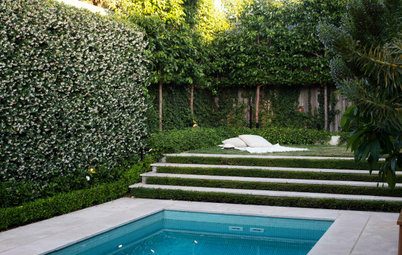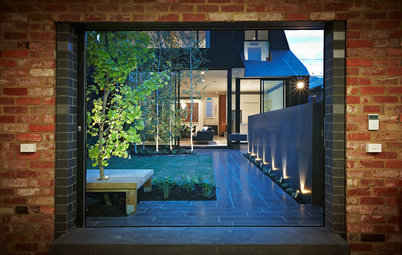How to Choose the Right Garden Edging for Your Outdoor Space
Often overlooked and undervalued, garden edging can mean the difference between a great space and one that is a maintenance nightmare
It’s a funny thing, garden edging. When it’s looking good and working, we barely give it a second glance. But, like a dripping tap, it can drive you mad as you attempt to wrangle the lawnmower, unsure where the garden finishes and the grass starts. Suddenly, garden edging becomes a little more interesting.
Things to Consider First
Your style
Aside from making maintenance easier, edging needs to reflect your home and garden’s style as much as all the other features you have. It should work with your planting themes, colour choices, the style of outdoor furniture you have and the overall ambience of your garden.
Find a landscape architect or designer near you to create the garden of your dreams
Your style
Aside from making maintenance easier, edging needs to reflect your home and garden’s style as much as all the other features you have. It should work with your planting themes, colour choices, the style of outdoor furniture you have and the overall ambience of your garden.
Find a landscape architect or designer near you to create the garden of your dreams
Longevity
It’s wise to base your choice not on price but the longevity of the product and how well it will hold up in your garden. Mowers and line trimmers can be unforgiving on products, such as bamboo, and some wooden edging doesn’t last long half-buried in the soil. Wire may look good but will let the grass wander, and some plastics are not strong enough and quickly buckle under pressure.
That’s not to say these products don’t work, just not in all situations. Wire, for example, can look great in a cottage-style garden with heaving planting near a path; bamboo in small areas is also effective to create a strong theme. Both make up in visual appeal what they lack in maintenance practicality.
It’s wise to base your choice not on price but the longevity of the product and how well it will hold up in your garden. Mowers and line trimmers can be unforgiving on products, such as bamboo, and some wooden edging doesn’t last long half-buried in the soil. Wire may look good but will let the grass wander, and some plastics are not strong enough and quickly buckle under pressure.
That’s not to say these products don’t work, just not in all situations. Wire, for example, can look great in a cottage-style garden with heaving planting near a path; bamboo in small areas is also effective to create a strong theme. Both make up in visual appeal what they lack in maintenance practicality.
Price
We all know you get what you pay for and garden edging isn’t any different. If it is cheap then chances are it won’t last or it won’t look good for very long. If you can’t afford to have the type of edging you want in your entire garden, then consider mixing it up with a cheaper option.
Spend your money on tidying up the key areas, such as your garden’s entrance or alfresco dining furniture and areas, and always keep in mind maintenance and making it as easy as you can – a little money spent now will save you in the long run.
Your existing space
When choosing the best material for your site, look at the styles that already exist in your home and garden. Decide if you want the edging to be a statement element in your garden (if not in all areas then perhaps just in some), or if it needs to blend in and be partly hidden by the plants. You don’t need to have the same type of edging in your entire garden, but the styles do need to complement each other.
Finally, consider how durable your edging needs to be. Investing in good edging will make all the difference in the same way that a new frame can bring a painting back to life.
We all know you get what you pay for and garden edging isn’t any different. If it is cheap then chances are it won’t last or it won’t look good for very long. If you can’t afford to have the type of edging you want in your entire garden, then consider mixing it up with a cheaper option.
Spend your money on tidying up the key areas, such as your garden’s entrance or alfresco dining furniture and areas, and always keep in mind maintenance and making it as easy as you can – a little money spent now will save you in the long run.
Your existing space
When choosing the best material for your site, look at the styles that already exist in your home and garden. Decide if you want the edging to be a statement element in your garden (if not in all areas then perhaps just in some), or if it needs to blend in and be partly hidden by the plants. You don’t need to have the same type of edging in your entire garden, but the styles do need to complement each other.
Finally, consider how durable your edging needs to be. Investing in good edging will make all the difference in the same way that a new frame can bring a painting back to life.
Choosing the Right Material
Stone and concrete
These will last the test of time and suit contemporary exteriors, traditional gardens, and everything in between.
Stone and concrete
These will last the test of time and suit contemporary exteriors, traditional gardens, and everything in between.
- Pros: Heavier edging materials, such as rocks, concrete blocks and continuous concrete edging, hold up to nearly all environments and situations and last a very long time. The same materials can be used to build retailing walls, which is ideal if you want to be consistent. These materials come in a wide range of styles and sizes, and even continuous concrete edging can be tinted with oxides to add colour.
- Cons: Stone and concrete edging are not DIY options as they need to be laid well to get the most out of them. Plus, due to the wide profile of these materials, they tend to give a bold and visually heavy feel to a garden, which in some situations can be a negative.
Metal
More and more steel and aluminium edging is being used around contemporary homes.
More and more steel and aluminium edging is being used around contemporary homes.
- Pros: With its slim, virtually seamless edge, it is perfect for a wide range of garden styles. Easy to install and long-lasting, sexy curves, circles and straight lines are straightforward to incorporate. Both aluminium and steel come in several heights, from 50-millimetres up to 580-millimetres, depending on which metal you choose. While aluminium offers only one colour and finish, steel is available galvanised, stainless or Corten (which oxidises and rusts beautifully).
- Cons: Metal edging comes in long lengths, up to three metres, and installing it over uneven ground can be difficult, because although the product curves back and forth it does not flex up or down. Very hard rocky ground poses a few problems, and softer aluminium edging can be damaged by line trimmers.
Timber
This is a sustainable choice that blends into the natural surrounds.
Wire
Simple and elegant, this is a cottage garden’s best friend.
This is a sustainable choice that blends into the natural surrounds.
- Pros: Timber can be cheap and easy to install, and it comes in a wide range of styles. Used in combination with other materials, it can help visually merge areas such decking and pathways. Also, large wooden sleepers cut into sections and set vertically can create a sense of drama and scale.
- Cons: When it comes to longevity, wood can fall short. Even the hardest of woods will eventually be eaten by termites or rot, especially in wetter climate zones.
Wire
Simple and elegant, this is a cottage garden’s best friend.
- Pros: Wire looks fantastic in traditional cottage gardens where the focus is not on holding foliage in or out but to form an elegant visual edge to a garden.
- Cons: With no solid surface, wire can let grass, rocks, plants and mulch wander between separate zones. Wire is also difficult to mow or line trim against, making it more for show than function.
Thinking Outside the Square
Be imaginative with materials
As well as the off-the-shelf materials available, there are many more, which are only limited by your imagination. Old shipping rope, tyres cut in half, terracotta pipes, and even dinner plates… all can be used to define the spaces in your garden. Not all of them will look good in every garden and some are less practical than others, but they all have the ability to reflect someone’s style.
Be imaginative with materials
As well as the off-the-shelf materials available, there are many more, which are only limited by your imagination. Old shipping rope, tyres cut in half, terracotta pipes, and even dinner plates… all can be used to define the spaces in your garden. Not all of them will look good in every garden and some are less practical than others, but they all have the ability to reflect someone’s style.
Use edging in new ways
Another way to think outside the square is to use an edging material’s strength or flexibility in new ways. The amazing flexibility of some edging can be used to create intricate curved areas, adding a real sense of fun and mystery to your garden, as can be seen here.
Corten-steel edging looks great once it has weathered and rusted, and the higher profiles such as the 390-millimetre or 580-millimetre can be used as a garden within a garden to make an individual plant or tree a focal point. It can also be used to create steps in lawns or paths and retaining walls.
Another way to think outside the square is to use an edging material’s strength or flexibility in new ways. The amazing flexibility of some edging can be used to create intricate curved areas, adding a real sense of fun and mystery to your garden, as can be seen here.
Corten-steel edging looks great once it has weathered and rusted, and the higher profiles such as the 390-millimetre or 580-millimetre can be used as a garden within a garden to make an individual plant or tree a focal point. It can also be used to create steps in lawns or paths and retaining walls.
Your turn
Have you used garden edging? Tell us what’s worked and what hasn’t in the Comments below, like this story, save the images, and join the conversation.
More
Need to spruce up your outdoor area? Read 5 Steps to Finding the Right Landscape Designer for Your Home
Have you used garden edging? Tell us what’s worked and what hasn’t in the Comments below, like this story, save the images, and join the conversation.
More
Need to spruce up your outdoor area? Read 5 Steps to Finding the Right Landscape Designer for Your Home





















The ultimate purpose of edging is to define spaces. The most common is between a garden bed and the lawn or courtyard to make maintenance easier, but edging can be used within a garden bed to define and separate planting styles or contain plants.
It is also widely used to define pathways where curvaceous lines or clean straight edges can easily be achieved. With so many options on the market and an unlimited number in your imagination, which one is the best for your garden? Read on and find out…